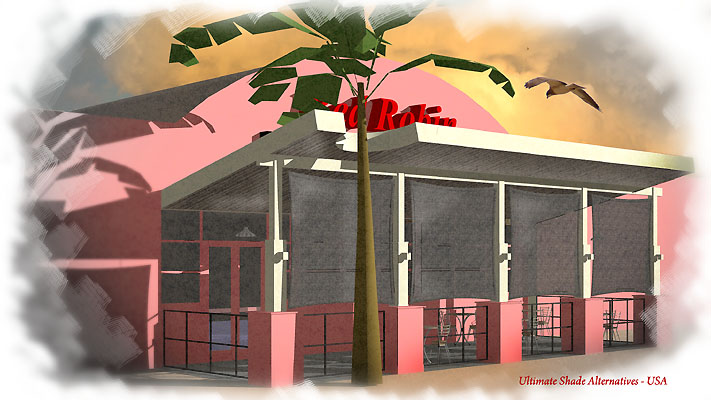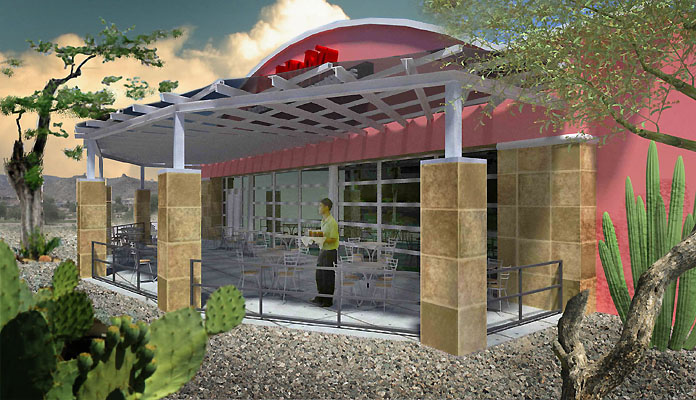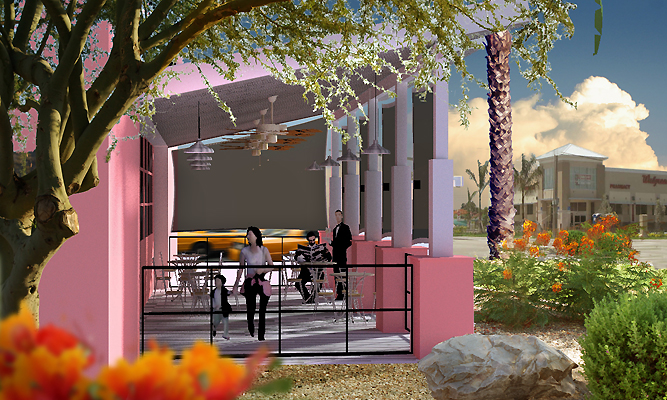Made in the Shade
-

Doing some shade structure renderings. According to an article in the Huffington Post, adaptive design to deal with changing environment has big business potential.
-
Very cool, I love the softness of the shade nets/sails over the windows.
Is the border a sketchup style or did you use a photo editor for the effect? -
Brian, I did the edges in PhotoShop. And the Building is at University and McClintock. Small world eh?
-
The basis for the sky was photo I shot in Spain last summer.
-
Wow, had no idea! so its an existing building in Tempe?
Looks like a Red Robin. -
Yup.
-
Good idea!
-
When HDPE (High density polyethylene)fabric is used to roof a parking structure and another similar parking structure is roofed in metal, there is a 30 degree difference in the interior of identical cars parked underneath. Not only does the metal not let heat exfiltrate through the fabric, It also reflects radiant heat bouncing off the parking lot back down on the car.
-
nice Roger... looks good.

-
I know shade sails are expensive, but sometimes I wish there were more of them in parking lots these days.
The hottest place in Phoenix is always your car when come out of the store/theatre/etc -
Private home installations start at around $5,000.
Also, car interior temps here in Phoenix are such that kids and dogs die in minutes. Happens every summer when the driver runs into a store for a few minutes. A pretty horrible death. I would have no compunction about breaking the glass.
-
Exactly!
some stores have trees, but they are so few and spread apart... it doesn't really do any good.
I wonder if shade sails would pay off in the long run instead of irrigating all those trees? -
Developers have houses designed to keep initial costs down. For the home owner there is purchase cost and operating cost. My mortgage is paid off and is no longer an issue for me. However my operating costs are ridiculous because no one designs with this in mind. Look at the early territorial houses and you will see big porches and long eaves. This keeps solar energy off of the main body of the house. But you no longer see this in modern housing.
Also few people really know how to calculate the cost of solar energy. So many people complain that solar is not yet practical, but most of the calculations I have seen do not take into account that a properly designed solar structure does more than produce electricity, it also shades the house if done right and thereby reduces electricity demand. When you put in that kind of double whammy factor the pricing starts to look a lot more attractive. Also, when your solar begins to approach replacement time, replacement cost should be lower in constant dollars than new construction as you are only replacing solar panels and not the expensive supporting structure.
Add to that there are a number of proven technologies in the process that will be way more efficient and are currently going through a fairly predictable series of engineering improvements. This means what is so so now will be come more cost efficient at replacement time.
We should not have to decide between passive and active energy systems. In good design these have to be combine into one design approach where the to avenues of thought support each other.
Also HOAs in their current form are a terrible blight. Start shading your house and these clowns will be all over you with poorly thought out regulations.
Older cities in hot parts of the world have long had narrow streets and tall buildings. In Arizona we have wide streets and short buildings. Why because developers came into the picture and designed for theri own needs and not the end users needs.
-
@roger said:
When HDPE (High density polyethylene)fabric is used to roof a parking structure and another similar parking structure is roofed in metal, there is a 30 degree difference in the interior of identical cars parked underneath. Not only does the metal not let heat exfiltrate through the fabric, It also reflects radiant heat bouncing off the parking lot back down on the car.
Who, in their sane mind, would cover a parking lot with metal?? It's madness!
-
@broomstick said:
@roger said:
When HDPE (High density polyethylene)fabric is used to roof a parking structure and another similar parking structure is roofed in metal, there is a 30 degree difference in the interior of identical cars parked underneath. Not only does the metal not let heat exfiltrate through the fabric, It also reflects radiant heat bouncing off the parking lot back down on the car.
Who, in their sane mind, would cover a parking lot with metal?? It's madness!
Broomstick, you spoiled my response by asking, "Who in their sane mind?." In spite of that, the answer is the entire Phoenix transit system, the veterans administration, numerous apartment complexes. This region has strong sun over 300 days per year and HDPE, even with UV inhibitors, will eventually rot away. Blue lasts the longest and red the shortest. This is because blue is closer to the UV end of the spectrum and reflects UV while red being on the long end absorbs UV. So if replacement cost is an issue metal lasts longer. People talk about the permanence of plastics but they mean buried in a landfill. In the sun they degrade quickly.
-
I see.. but what about using roof tiles?
-
-

Another set of Shade sails for a second Red Robin location. Twentyone hours of bake time with Metro Light Transport and Bidirectional Photon Tracing and it could have used double the time for more detail in the beams.
-
Looking good!
-

This view actually projects the feeling of cool shade in 115 degree F weather.
Advertisement







